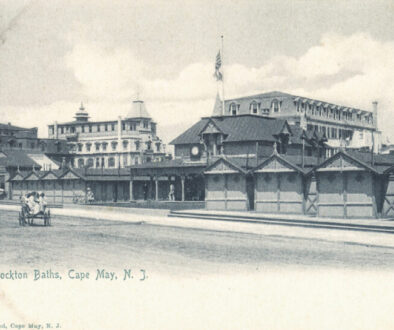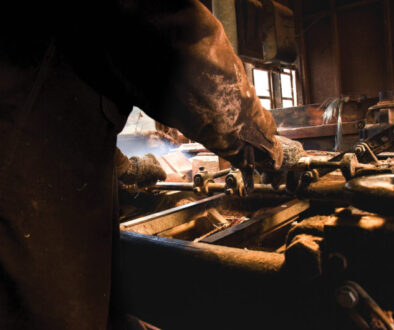Circles in the Sand
The Men and the Machines Behind Cape May’s Pristine Beaches

Plastic bottle caps. Cigarette butts. The hard, black cases of skate fish embryos. Sharp spines of dried sea grass lurking, waiting to puncture an unsuspecting foot.
Walking along the beach in Cape May in the middle of July, it’s unusual to come across any of those items, and for good reason: From dusk until dawn, two giant tractors from Cape May City Public Walks trundle along the coastline, towing behind them the equipment responsible for leveling the sand and clearing away all manner of debris.
“We’re out there even if it’s raining. It’s an art. You can keep it clean because you know how you’re doing it,” says Joe Picard, Superintendent of Cape May City Public Works. “The next day, people are amazed at how flat it is. We get compliments all the time about how pristine our beach is.”
Sweeping and grading the beaches of Cape May—and beaches everywhere—is a costly, time-consuming, and somewhat controversial endeavor. Advances in technology have mitigated some of these issues, but it still comes down to the partnership between human and machine to find the balance between litter-free sand, healthy biodiversity, and authentic natural experience.
The Process
Maintenance occurs in three stages over the course of the year. During the winter, the beaches are left alone, with no cleanup activity at all.
In April, the Public Works crew emerges, scouring the beach for debris that has accumulated over the winter months and clearing it away. “Logs, pilings, pieces of wood, bulk stuff,” Picard explains. Once the large items are removed, the crew then begins the raking process, catching smaller pieces in the tines of the 12-foot metal rake towed behind the tractor. This step is followed by a rough grading to clean up grass and seaweed, a process that lasts about a month. The last phase is to switch out the rake for a machine the crew calls the “sanitizer” to shape the beach in a final pass—”to clean it, level it, and make it look pretty,” Picard says.
Then the season kicks in. From Memorial Day to Labor Day, two tractors patrol the beach seven days a week, from 8pm to 4am, raking smooth the remnants of the day’s visitors—their moats, pits, castles, and footprints—and sweeping away everything from beverage cans to shells.
Machine operators also respond to daytime needs. “We might need to go out if kids dug a giant hole during the day,” says Picard. “The beach tag checkers will call it in.”

The Experience
Bryan “Squirrel” Harron has been a heavy equipment operator with Public Works since May 2010. (Note: He earned the nickname ‘Squirrel’ because he apparently never sits still. Fittingly, he stood during the entire interview.) One of five members of the cleaning crew, Harron cites his general love of the beach as a positive aspect of the job. But what about those overnight shifts during the season? For Harron, they’re a treat. “I enjoy night work, because no one is here to bother you,” he says.
Bob McCloskey concurs. “It’s great.” McCloskey is Assistant Supervisor of Public Works, with 25 years of beach cleaning experience of his own. “You put your music on, and there’s no one else. Back when we only had one tractor, it was just you out there.”
There are other benefits. “There’s no traffic on my commute,” Harron continues, “and I have all day off.” Every Wednesday, he takes his kids to the water park or to the beach, something he would be unable to do working more traditional hours.
A major perk is the money. Overtime is shared among five heavy equipment operators who rotate shifts throughout the season. And Harron cites job security, in the form of a pension and benefits, as a key source of job satisfaction among the entire crew.
Working with the public is rewarding, too. “Every now and then, we get a request for someone who’s lost a phone, or keys, or their clothes, or a wallet,” Harron shares. While the waste collected ultimately goes into a dumpster and then into the landfill, there have been plenty of items recovered and reunited with their owners. And then there are the fans: “Both kids and parents get really excited about the equipment,” he says.
A typical shift incurs predictable shenanigans: The teenagers who run around and try to jump on the back of the machine, or the amorous couple oblivious to the encroaching tractor. McCloskey shrugs it off. “We don’t bother with them. They go about their business, or they get the hint and move on.”
Harron identifies the coolest experience of all, though. “When a big storm rolls in and you get a good lightning show while you’re out there.”
The “Nuts and Bolts” (and Belts and Tines)
Cape May uses two Barber SURF RAKE sanitizer machines to collect trash. Unlike other machines that sift sand and debris through a screen, the SURF RAKE employs tines on a motorized belt to rake through the sand and lift only the debris. As a bonus, Picard notes that these machines are both quieter and easier to maintain than their previous sifter models.
Melissa Corcoran, National Sales Manager for the SURF RAKE’s manufacturer, H. Barber & Sons, Inc., provides further detail. “The way the beach should be cleaned was evaluated by our founder, Hal Barber, all those years ago. It would have been easy for him to modify existing sifting or screening equipment and call it a beach cleaner. But he worked with big screeners before, and he knew that picking up the beach and putting it through a screen everyday was unnecessarily disturbing the sand. He had observed that sifting sand was infused with air that would make it blow away and potentially wash away more readily, especially if it was done on a regular basis. He designed the SURF RAKE so that offset rows of stainless steel tines revolve through the sand, capturing and lifting only the debris, and not the sand itself. This process is less intrusive to the environment.”
Harold “Hal” Barber was an engineer working as a salesman for Caterpillar in the 1950s when his familiarity with their farm and construction equipment sparked the idea to apply the features used for harvesting potatoes and hay to beach refuse removal. “Working at the Jersey shore during the early boardwalk development days, Hal was in awe of its beauty and knew others would be too,” Corcoran recounts. “He imagined a lot of people were coming, and he wanted to make sure the beaches didn’t turn into landfills. He realized the need for specialized equipment to keep the beaches beautiful and protect marine life.” His vision led him to create the company, which is today located in Naugatuck, Connecticut.
Corcoran wastes no time in extolling the virtues of the SURF RAKE. “Some of the features that make it stand apart from competitors are its eco-friendly grid raking technology and the fact that it exerts less than 10psi ground pressure on the sand (roughly the same ground pressure as an adult male walking on the beach), making it the only machine approved for use during sea turtle nesting season in many parts of the country. Additionally, the SURF RAKE also uses a low-pressure hydraulic system capable of running on environmentally-friendly bio fluids such as canola oil.”
With holes that are about ¼ inch in diameter, the smallest items the machine picks up are cigarette butts or small stones. On the day I visited in early May, the hopper of the machine was partially full of a mix comprised mostly of dried sea grass with a few bottle caps and cigarette butts.
When attached to the tractors, the machines sweep a wide, efficient swath, but challenges arise when they need to navigate obstacles. Some of those obstacles are hidden, such as ropes that beachgoers bury to anchor their tents to the ground. Others sit on top of the surface, including walkways out to the beach. “With the new ADA laws, we have been providing more and more walkways,” says Picard. “Those walkways, as well as hotel cabanas, take up a lot of the beach we clean. We can’t turn on a dime, and so those features start to cut down on how much of the beach the machines can clean.” These days, operators simply stay out beyond the areas between the beach entrances with the walkways, leaving that work to employees who sweep the mats by hand.

The Evolution of Beach Cleaning Practices
The popularity of using machinery to clean the sand surged in the 1980s, when medical waste was washing up on New Jersey beaches with alarming regularity. Although disposal practices were the cause, cleanup methods became a powerful and visible strategy to mitigate the ensuing PR nightmare. No longer just an aesthetic issue, thorough and regular cleaning of the coastline was now a safety consideration as well. But in recent years, the environmental impact of these machines on wildlife, habitat, and biodiversity has received an increasing amount of attention.
In 2013, Cape May Point scaled back their mechanical beach cleaning, employing their SURF RAKE only three times that year—just prior to Memorial Day, Fourth of July, and Labor Day. For the rest of the season, they tasked their beach tag checkers with carrying grabbers and plastic bags to collect litter by hand. The change resulted from a three-year lobby by concerned residents that mechanical beach cleaning was destroying their beach’s biodiversity.
Cape May Point resident Emelia Oleson led the effort, citing studies that show mechanical beach cleaning to be detrimental. In a September 6, 2013 article in The Press of Atlantic City, Oleson asserts, “It’s bad for the beaches. It brings the smaller particles to the surface, and they blow away. They take the wrack [high tide] line to the landfill. You’re destroying the little critters in the wrack line, and they help build up the dunes.”
Corcoran counters that mechanical beach cleaning was actually inspired by the environmental impact trash and litter has on the beach and marine ecosystem. “Every day we read about the damage this debris is doing to our oceans, sea life and food supply,” she says. “We feel there will always need to be a balance between mechanical beach cleaning and environmental concerns. While the title ‘environmentalist’ is a more modern-day term, we like to think of Hal Barber as an early environmentalist. Having lived and worked in New York, he had seen firsthand how much trash a concentrated population could produce.”
She is quick to acknowledge the complexity of the industry, though. “We appreciate that there are entities that choose not to engage in mechanical beach cleaning for their own reasons, including environmental concerns, and we understand and honor their decision. However, given the opportunity, we share that we are also concerned with the environment and feel that in many cases, it would be more detrimental to the environment to forgo cleaning and leave the trash.”
It is a wide spectrum. Although Cape May Point’s comparatively tiny area might be able to flourish with the manual trash cleanup, the same approach doesn’t work everywhere. On the vast expanse of Wildwood’s beaches, three or four machines run from 4 am until noon every day of the season. And even in Cape May Point, their manual trash collecting experiment fizzled out, with the borough returning to using a Barber SURF RAKE during the busy season.
There is not a one-size-fits-all solution, and even a single beach must alter its practices throughout the year. For example, in a February 15, 2012 blogpost from the Barber Company titled “Balancing Environmental Concerns with Beach Attractiveness,” Barber describes examples of how a flexible approach can work. “Despite the visual and safety benefits of removing seaweed and other wrack from the tide line, certain beaches are mating grounds for certain rare or endangered sea creatures, which are negatively affected by beach cleaning. For example, Grunion fish in southern California lay their eggs and spawn on the beach surface from March through June each year. During this time, all mechanical beach cleaners are prohibited from operating below the tide line.”
In other situations, adjusting the settings on the beach cleaner can provide a solution. Sea turtles in Florida, for example, lay their eggs in the sand, and a deep-digging beach cleaner could remove or damage these eggs and quickly destroy the sea turtle population. “Instead,” the post offers, “each cleaning is allowed with mechanical beach cleaners when they follow certain strict regulations. Specifically, Florida requires that the machine’s footprint is 10 psi. Large floatation tires distribute the machines weight and allow for such even weight distribution, which keeps the weight of the machine from crushing the buried eggs. Similarly, machines are not allowed to clean more than two inches below the sand’s surface, as the eggs are typically buried about 10 inches deep. Adjusting the beach cleaner’s moldboard apparatus to a two-inch cleaning depth ensures that the machine’s tines clean surface material without disturbing the eggs below.”
Locally, Cape May adjusts its own routines to accommodate the Piping Plover population. In the area extending beyond Wilmington Avenue near the Coast Guard base, there is a “no rake” zone from March 15 through August when the birds are nesting. “We come up to Baltimore Avenue, three blocks before the nests of the birds,” explains Joe Picard. “At the other end, there are birds and some vegetation, with sections roped off where the birds are nesting.”
Barber has customers all over the world, and Melissa Corcoran points out that New Jersey shore communities are making good decisions, at least from Barber’s perspective. “Certainly, Cape May is conscientious not only with its beach equipment, but with its dune management program that helps protect the beach and provides marine habitat,” she affirms. “Most of your New Jersey shore towns work hard to create a balance. Most have SURF RAKES, so in my book they have made the decision to protect their beach and marine life and clean the sand in an eco-sensitive way.”


Completing the Circle
Looking after the wellbeing of local beaches extends beyond Cape May’s Public Works Department. Truly, everyone has a role to play in the pursuit of a clean coastline and environmental stewardship. Keeping trash from littering it in the first place is part of that process. Some of the leaders in that effort come from a surprising population: the students of Cape May County’s public schools.
During our interview in Joe Picard’s office on Canning Road, Pat D’Arco, Administrative Assistant to Public Works, entered the room, proudly proffering a spreadsheet containing the results of Cape May County Schools’ Plastic Bag/Film Collection Challenge held last October. With a staggering 11.78 bags per student—almost two units more than second place and more than double that of third place—the pupils at West Cape May Elementary School took the win. “And with only 84 students, too,” D’Arco exudes.
The contest was so successful that the Cape May County Municipal Utilities Authority ran a follow-up competition that took place between November 15, 2018 and April 15 of this year. Again, Cape May came out on top, this time with the 152 students of Cape May City Elementary School bringing in over one ton of plastic bags and film, earning them the prize of a TREX recycled composite bench that will be installed outside their school. Additionally, each child received a recycled plastic bracelet from surf cleanup company 4ocean. “Out of all the kids in all of Cape May County, in all the different categories, they won,” beams D’Arco. “So they’re getting a pizza party too.”
“It takes a village,” the old adage goes. From the kids of West Cape May Elementary dutifully depositing mounds of plastic into their school’s collection bin to the lights on Bryan Harron’s tractor carving endless spirals into the 3am darkness, Cape May’s beaches are in capable hands.



